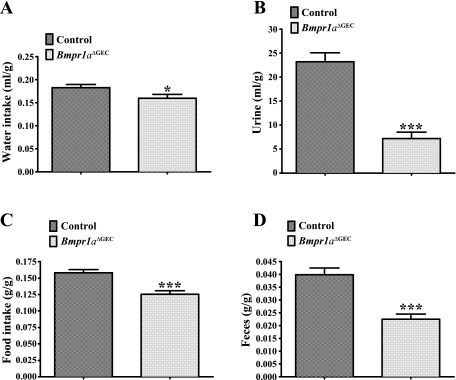Fig. 8.
Impact of loss of gastric epithelial BMP signaling on liquid and solid metabolism. Bmpr1aΔGEC (n = 6) and control mice (n = 6) metabolism was evaluated on a 7-day period to assess the impact of the mutation on diet. Liquid metabolism (A and B) and water ratios (milliliters of water per gram weight) indicate a 15% decrease in consumption for Bmpr1aΔGEC compared with control mice (A), whereas urine ratios (milliliters of urine per gram weight) indicate 70% less excretion for Bmpr1aΔGEC mice compared with controls (B). Solid metabolism (C and D) and food ratios (grams of chow per gram weight) show 20% less consumption for Bmpr1aΔGEC mice compared with controls (C), whereas fecal excretion (grams of feces per gram weight) dropped by 43% for Bmpr1aΔGEC mice compared with controls (D). Water and food intake data were analyzed with the unpaired t-test and urine and feces data with the nonparametric Mann-Whitney test; *P < 0.05, ***P < 0.001. Error bars represent SE.

